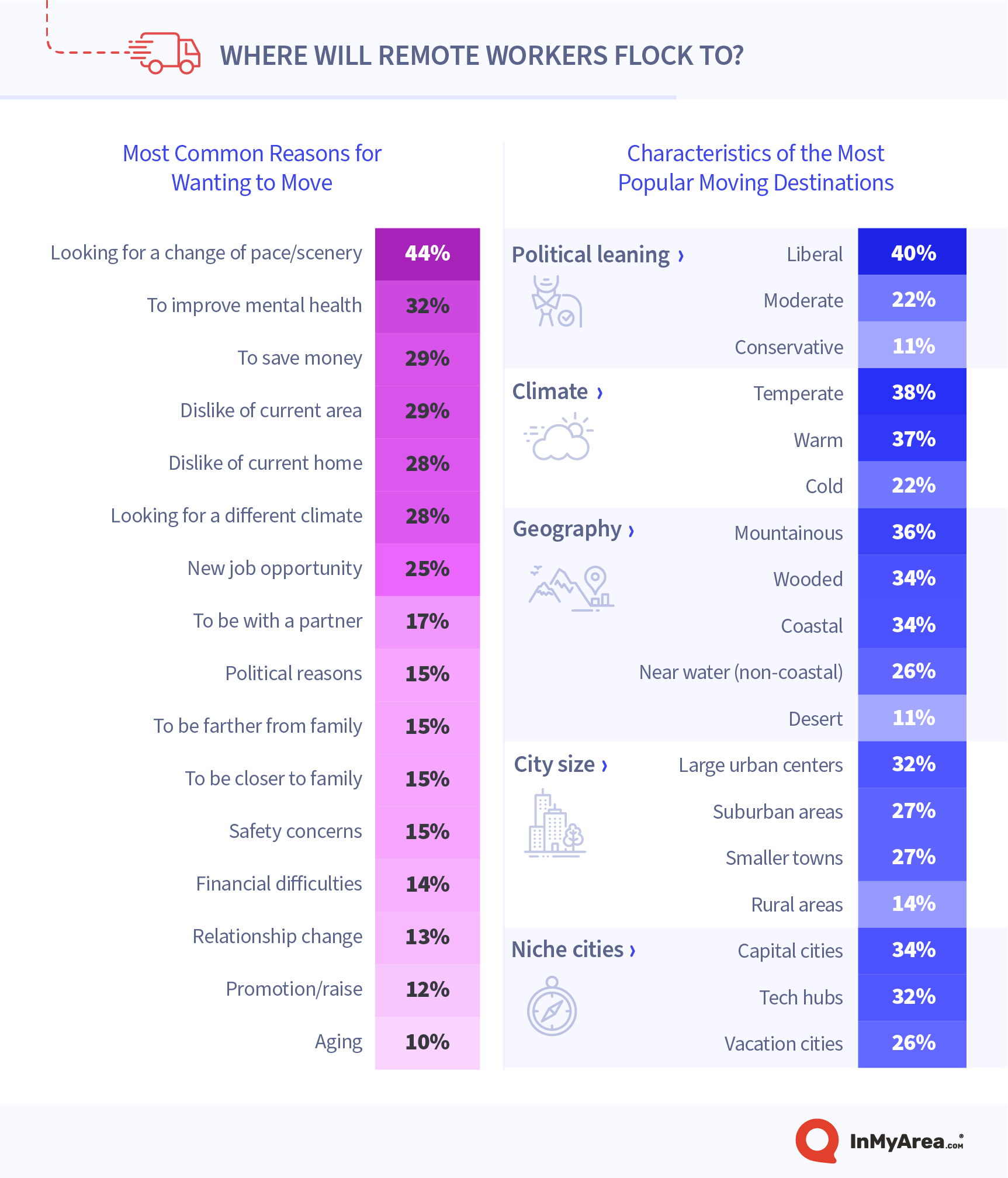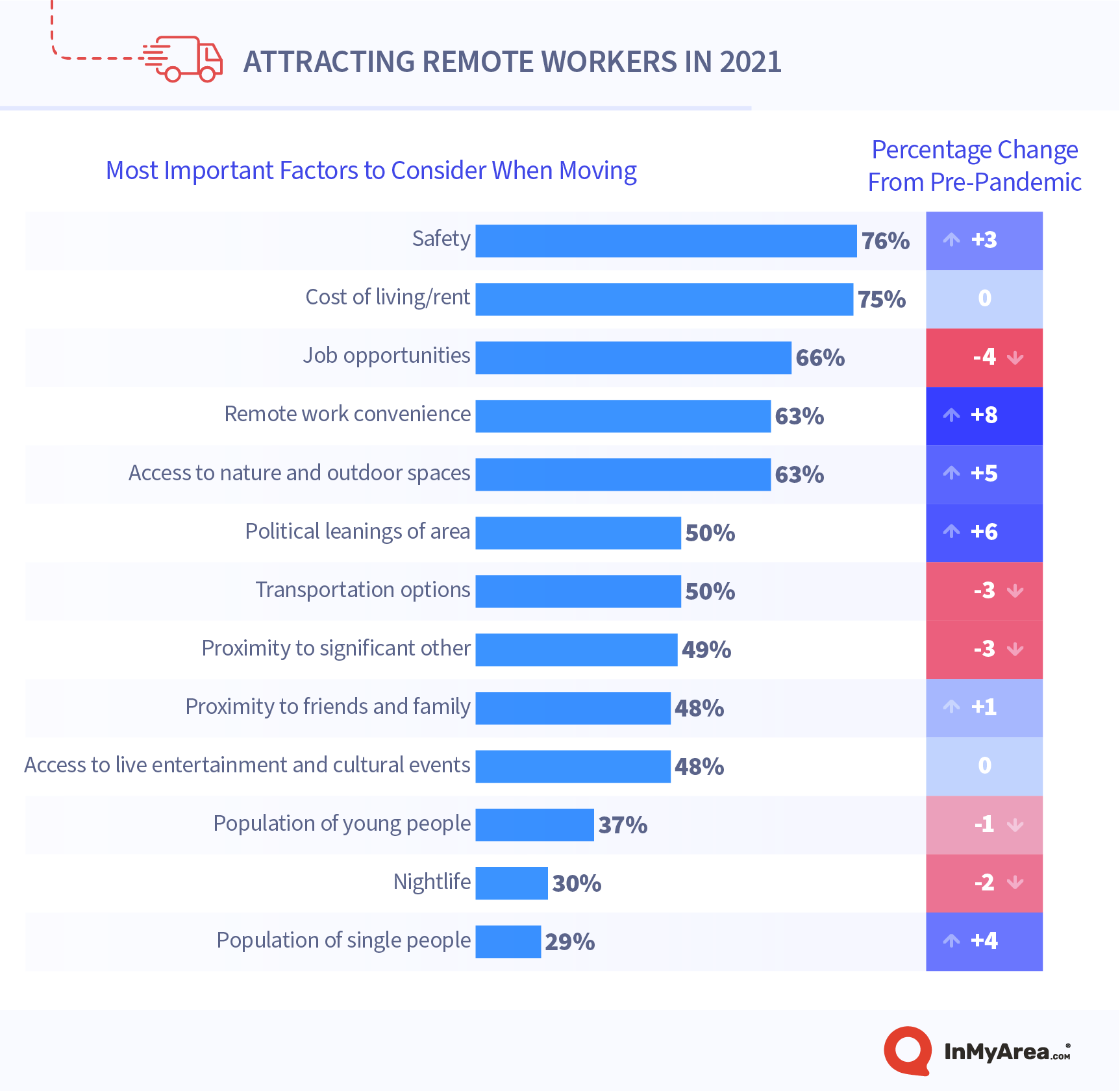Since the beginning of the COVID-19 pandemic, some studies have claimed that a vast migration of millions of Americans will happen in the wake of the COVID-19 pandemic due to a dramatic increase of remote work. Young, unmarried Americans are a major part of the growing remote workforce in the U.S – a natural instinct for technology combined with relatively few family obligations make for a demographic ready to meet the challenge of taking careers outside the office.
Having studied the landscape of best locations for remote work in the past, we sought to understand how the exceptionally mobile set of young, single remote workers are approaching moving decisions in 2021. Our new study examines how accurate these claims of mass migration might be. Do millions of Americans really want to move, and if so, where are they going and why?
Key Findings
- 49% of young, unmarried remote workers who are considering moving say they plan to make good on those plans this year.
- Despite some reports of young remote workers moving out of large cities en masse, we found that this exceptionally mobile demographic is still most interested in living in large, liberal, well-populated cities with good access to the coast, forests, or mountains.
- When considering moving options, young, single remote workers are significantly more interested in having access to outdoor spaces and fitting in politically than they were at the beginning of the pandemic. Safety and cost of living still rank as the most important factors overall, though.
Relocation Plans
The Americans we asked about relocating ranged in age from 18 to 35 years old, and all of them had a permanently remote job when surveyed. According to our results, 62% of remote workers were satisfied with their current city or area, while only 21% were dissatisfied. Tech workers – a demographic that has received considerable attention in the remote work conversation – tended to be slightly more disgruntled with their current living location, with 28% claiming to be dissatisfied.

While the majority were happy with their current location, about 64% of respondents had seriously considered moving since the start of 2021. Almost half of those who were thinking about moving had plans to do so this year, meaning that the U.S. could potentially see the movement of millions of young, unmarried remote workers in 2021.
Urban residents were the most likely to report that they’re planning to move before the end of 2021, followed by suburban residents. Rural residents were the least likely to move in 2021. Even though non-urban residents were less likely to plan a move this year, they were also nearly twice as likely to feel dissatisfied with their current location. This disconnect between action and emotion suggests that remote workers outside urban areas feel more stuck than their city-dwelling counterparts.
Most Desirable Places to Live
People have many reasons for wanting to move, but what exactly is driving many Americans to make this choice right now? We asked our group of young remote workers about the top reasons they’re planning to move plus where they’re most interested in going.

Overall, young remote workers appeared most interested in moving to large, liberal urban areas despite previous reports of people fleeing cities due to the pandemic. For many, moving to a warm or temperate climate was also more desirable than relocating to a cold climate. More than a third wanted to live near mountains, forests, or the coast, probably to enjoy the amenities of city life plus all that the great outdoors has to offer. Many people reported a desire for safe recreational places outside the city but that were still close to home.
When we took industries into consideration, tech workers once again stood out from the pack. More so than others, they wanted to move because they didn’t like the area in which they were living or were unhappy with their home. Almost half of these young tech workers (47%) were simply looking for a change of scenery. Fortunately for this group, many smaller cities are trying to draw in tech workers with relocation programs.
Remote workers can also find moving incentives in the following states and cities:
- Hamilton, OH
- Harmony, MN
- Hawaii
- Kansas
- Manilla, IA
- Newton, IA
- Northwest Arkansas
- Savannah, GA
- The Shoals, AL
- Topeka, KS
- Tucson, AZ
- Tulsa, OK
Maine, Alaska, Baltimore, MD, and certain towns in West Virginia are also providing monetary incentives or tax rebates to encourage people to move in. These communities are hoping to boost their economies, and in return, they provide new residents with plenty of benefits, such as more affordable housing, less crime, and a slower pace of life.
Moving Motivations
Due to a variety of factors, where you live has a great impact on your quality of life. So, we asked our young remote workers what could entice them to move from their current location. What are the majority looking for in a new hometown or city? We also examined how their feelings might have changed since before the pandemic.

Since the start of the pandemic, young remote workers have become much more concerned about the political leanings of where they live. This result isn’t a surprise given how divisive politics have become in recent years. These young Americans are also much more concerned about how conducive a location is to remote work and how easy it is for them to access nature.
Men and women tended to agree on the most important factors to consider when moving. The only difference we found was that men considered nightlife and the number of single people in an area more important than women did.
The number of single people in an area ranked as the least important factor young remote workers consider when moving. However, this factor has increased in importance since the beginning of the pandemic. Perhaps young, unmarried remote workers are feeling more social isolation than before and are seeking places where it’s easier to connect with people their own age. Among many factors that are important to consider when looking for a spot to work remotely, it’s key to factor in housing costs and internet speeds. Remote workers looking to move to a big city – a plurality, according to our data – should check out San Antonio, TX before making a decision: According to our ranking of Best U.S. Cities for Working Remotely, San Antonio is a top contender.
Conclusion
A great American migration may be under way as remote work becomes the new norm for many people. Why settle for a lower quality of life when you can move to a better place and keep the job you love? Smaller cities and less populated states are seeking to capitalize on this historic event by offering relocation incentive programs.
Young, single remote workers tend to enjoy a lot of mobility when it comes to their life and job. The majority of them are thinking about moving in the near future to places that are safer and more affordable. They most desire a change of pace and scenery and also hope a move might improve their mental health.
Our Data
Our data were gathered from a survey of 541 unmarried people between the ages of 18 and 35 (median 28) who work remotely on a permanent basis. Of those, 273 were women, 254 were men, and 13 were nonbinary or nonconforming. One chose not to disclose their gender. 240 respondents lived in urban areas, 247 were in the suburbs, and 54 were rural residents. 115 worked in the technology industry, and 426 worked in other industries. All participants passed an attention-check question.
The data we’re presenting rely on self-report. Self-reported data is vulnerable to limitations including, but not limited to, the following: attribution, exaggeration, telescoping, and selective memory.

